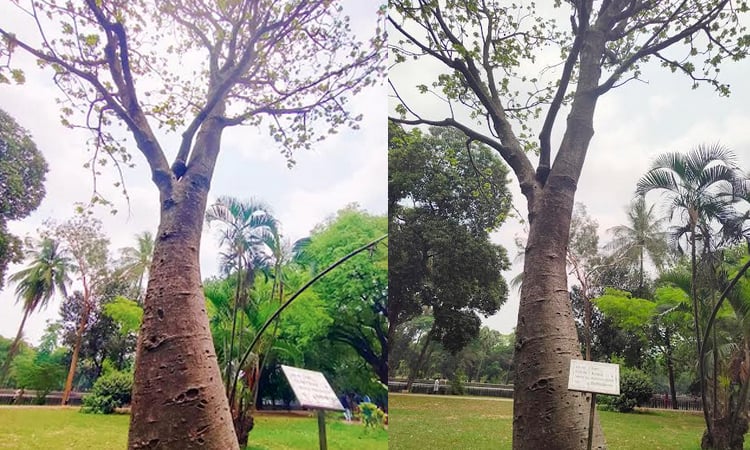News Flash

By Mahamudur Rahman Nazid
DHAKA, May 14, 2025 (BSS) - Ramna Park, a cherished green retreat in the heart of Dhaka, has long been considered as a haven for nature lovers and city dwellers seeking respite.
Among its diverse collection of trees, an unexpected discovery has sparked excitement— a rare species of Baobab Tree, adding to the park’s botanical charm. This unique find is a delight for environmental enthusiasts, further enriching the park’s reputation as the city’s natural sanctuary.
Nestled in the heart of Dhaka, Ramna Park is more than just an ancient green space— it serves as a living plant museum with a rich collection of indigenous and foreign trees. Among its diverse flora are Kanakchapa, Kursi, Escalate, Bhadra, Jakandha, Nagerswar, and Parijat.
Recently, nature enthusiasts have been captivated by the presence of a rare baobab tree (Adansonia digitata), an extraordinary addition to the park’s botanical diversity.
According to Wikipedia, the baobab tree is native to the Sahel region of Africa, Madagascar, and parts of Australia, making its presence in Bangladesh highly significant, as it does not naturally grow in the country.
The defining characteristic of the baobab tree is its unique structure. Its massive trunk rises vertically from the ground, while its branches spread out at the top, resembling an umbrella.
During winter, when the leaves shed, the tree appears lifeless, only to sprout new foliage at the end of summer. It can grow up to 75 feet tall.
Adapted to dry environments, the baobab requires minimal water and boasts an astonishing lifespan of thousands of years.
Its thick trunk, unusual form, and seasonal leaf-shedding set it apart from other trees, making it a fascinating sight.
Due to its distinctive appearance, many refer to it as the “upside-down tree”, as its bare branches in winter resemble roots extending into the sky.
The baobab tree is renowned for its medicinal and nutritional benefits. Its fruit, often hailed as a superfood, is packed with vitamin C, calcium, fiber, and antioxidants. Once dried and powdered, it is commonly incorporated into drinks and various health-focused foods.
Beyond its fruit, the leaves and bark have long been utilized in traditional African herbal medicine for their therapeutic properties. Additionally, the tree’s fiber is remarkably strong, making it ideal for crafting durable ropes and clothing.
Shahadat Hossain Anu, a regular visitor to Ramna Park, shared his experience: “I come here for a walk every day and have seen many trees, but this baobab tree stands out completely. At first, I couldn’t identify it, but later, the signboard revealed that it is a renowned tree from Africa. It’s fascinating to have such a unique tree in Dhaka, and it can serve as a valuable educational resource for children.”
Professor Dr Shahriar Ahmmed, Chairman of Department of Botany at Jagannath University, highlighted the rarity of the baobab tree in Bangladesh.
“This species is not only visually striking but also holds significant research value,” he said, adding, “Given its long lifespan, it plays a crucial role in maintaining ecological balance. Its ability to store water in its trunk and its unique pollination process—facilitated by bats at night— make it a remarkable natural wonder.”
He further added, “While our focus is often on native tree species, globally significant plants like the baobab enhance our botanical diversity. If properly preserved and cared for, its presence in Ramna Park could become a valuable ‘botanical heritage’ for us.”
According to different sources, the baobab tree is a large, iconic tree native to Africa, Madagascar, and parts of Australia. It belongs to the genus Adansonia.
It’s scientific name Adansonia digitata. Adansonia: Named after Michel Adanson, an 18th-century French botanist who studied the tree in Senegal. Digitata: Refers to the shape of the tree’s leaves, which are often divided like fingers.
Baobabs are among the longest-living trees in the world. Some are estimated to be over 1,000 years old, with certain trees believed to be more than 2,500 years old. It is also called the “Tree of Life”, which comes from the baobab’s incredible ability to store water.
Baobab’s thick trunk can hold thousands of liters of water, which helps it survive long droughts. It provides food, water, shelter, and medicine to people and animals, especially in dry African landscapes.